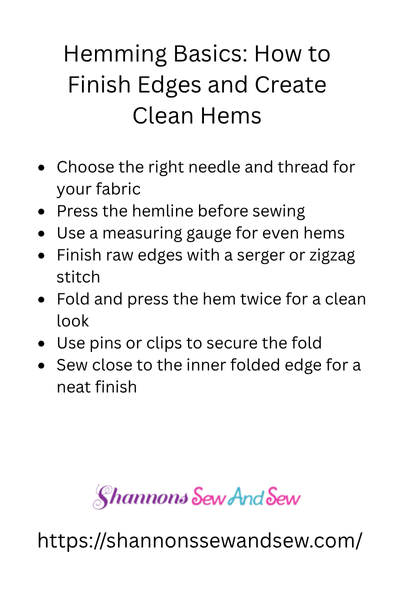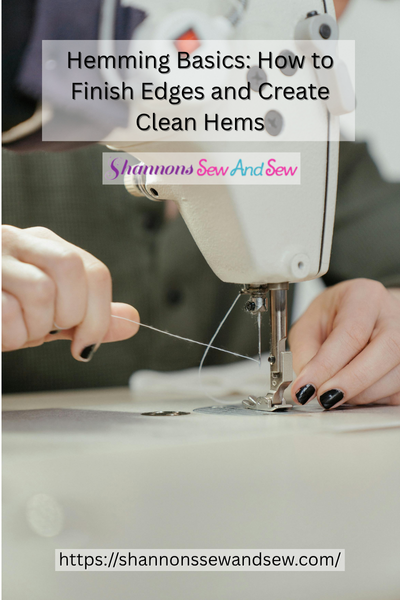Sewing For Beginners
Hemming Basics: How to Finish Edges and Create Clean Hems
If you’re diving into sewing or just tired of fraying edges driving you nuts, hemming basics: how to finish edges and create clean hems is something you need in your back pocket.
Now, I get it—hems might not sound thrilling. But trust me, once you’ve got the hang of it, your sewing game levels up fast. Whether you’re hemming pants, curtains, or that hoodie you accidentally cut too short (guilty!), knowing how to do it cleanly makes all the difference.
Read More About Hemming Basics: How to Finish Edges and Create Clean Hems

Let’s Talk About Why Hems Matter
Before I ever touched a sewing machine, I thought hems were just… you know, there. Like, magically. Then I made my first DIY apron, and when I washed it—BOOM. Frayed, floppy mess. That’s when I realized: a good hem is the unsung hero of sewing.
Hemming basics: how to finish edges and create clean hems isn’t just about making stuff look neat. It’s also about strength. A clean hem keeps your fabric from unraveling, helps it lay flat, and gives your projects a polished, professional feel—even if you’re still figuring out your bobbin from your bias tape.
More Things to Know About Hemming Basics: How to Finish Edges and Create Clean Hems

Picking the Right Hem for the Job
There’s no one-size-fits-all hem, and that’s kind of the fun part. (Yes, hemming can be fun—stick with me.)
Say you’re hemming jeans. You’re gonna want a sturdy double-fold hem that can handle wear and tear. But if you’re working with a floaty fabric like chiffon? That calls for something delicate, like a rolled hem or a baby hem.
Hemming basics: how to finish edges and create clean hems means understanding your fabric, your project, and your tools. It’s a little bit of science, a little bit of art—and sometimes, a bit of trial and error.
So, What’s the “Basic” Hem?
Glad you asked. The double-fold hem is my go-to for most things. Here’s how it goes:
- Fold the edge of your fabric over once (usually about ½ inch).
- Press it with your iron. (Yes, please press your hems—don’t skip this!)
- Fold it again the same width so the raw edge is hidden.
- Stitch close to the folded edge.
Simple, right? And clean! That’s the heart of hemming basics: how to finish edges and create clean hems—keeping it tidy without overthinking it.
Now, if you’re in a hurry or dealing with bulk, there’s also the single-fold hem. Just one turn and stitch. But beware: raw edges can peek out over time unless you finish them with a zigzag stitch or a serger. (No serger? No problem. I didn’t have one for years and made do with a trusty zigzag.)
When the Fabric Fights Back
Let’s be real: not all fabrics play nice. Knit hems? Oh, they can stretch and wave like a flag in the wind. Slippery synthetics? Don’t even get me started.
But don’t stress. With a few tweaks—like using a walking foot, hemming tape, or even hand basting before you sew—you can totally win the war against wonky hems.
I once tried hemming a silky slip dress with no stabilizer and no plan. I was overconfident and underprepared. Let’s just say the result looked like a ruffle accidentally happened. Lesson learned. That’s why I always test a scrap now before I commit.
Hemming Doesn’t Have to Be a Headache
A lot of folks (especially beginners) get intimidated by hemming. And hey, I’ve been there. But remember, hemming basics: how to finish edges and create clean hems isn’t about perfection. It’s about practice and paying attention.
You don’t need fancy tools or a million gadgets. A good iron, sharp pins or clips, and some patience go a long way. And honestly? You’ll surprise yourself with how fast you pick it up.
And if you do mess up? It’s just fabric. Unpick it, take a breath, and try again. I’ve done this more times than I can count—and my projects are better for it.
Finishing Up: Hemming Basics Are a Game-Changer
So there you have it: hemming basics: how to finish edges and create clean hems in a nutshell. Whether you’re patching your work pants or sewing up a cosplay cape, a clean hem gives your project the finish it deserves.
If you’ve ever looked at store-bought clothes and thought, “How do they make it look so… finished?”—well, now you know. It’s all in the hem.
Go grab your fabric, fire up that iron, and give hemming a try. You’ll feel like a total sewing boss in no time. And if your first few hems aren’t perfect? Welcome to the club—we’ve got cookies, crooked stitches, and a whole lot of creative joy.
Sewing Skills Start With Simple Practice
You’ve got the know-how, now it’s just about giving it a go. Don’t overthink it. Pick a scrap fabric and start folding and stitching. Try different styles. Mix it up. You’ll get the feel for it fast—and your future sewing projects will thank you.




















